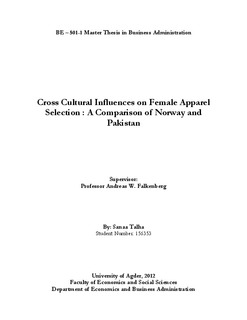| dc.description.abstract | The objective of this study was to investigate and compare the impacts rendered on the consumer
choices and selection behavior cross culturally, specifically for the casual wear among well educated
female consumers of Norway and Pakistan. The criteria used were based on the several cultural traits
recognized as well as clothing values. The clothing values are basically the meaning or the types of
associations a consumer form with the selective clothes. Clothing is a very integral part of one’s life.
There is a small poem by William Allen Butler, called "Nothing to Wear"; It goes like this:
Dresses for breakfasts, and dinners, and balls;
Dresses to sit in, and stand in, and walk in;
Dresses to dance in, and flirt in, and talk in;
Dresses in which to do nothing at all;
Dresses for Winter, Spring, Summer, and Fall.
This is a very precise but accurate description of the use and importance of clothing in one’s life.
Naturally for every second of every day one need some kind of clothes to wear. There are millions
of different people around the world with million different preferences and choices. So the question
is what does the consumer really need, and why does one purchase what they do?
The simplest answer is that the consumers buy things what they are accustomed to and what they
feel comfortable with. This level of comfort is derived by some inherent in built guides that make
the consumer go in a particular direction every time the go clothes shopping.
Someone once said everyone loves what they shop but hate everything in their wardrobe. Female
clothes shopping behavior according to many is very annoying and cumbersome, but somehow the
results seem the same for every time. It is possible for a person to have too many black shirts, and a
thousand and one reasons given for why they have a 100 black shirts, it was on sale, that’s all there
was left, the store didn’t have any other variety. True in some instances these are excuses. The
reasons are the latent motives in one’s mind. One might think that black makes them look smarter,
or maybe it makes them look more serious and hence treated with higher care and respect, or
because it is the signature color of the sports team one follows or maybe even because it is the
favorite color of a loved one. These are some motives that are defined by the surroundings one lives
in and hence are the product of the dominant culture around.
The study aims at understanding what are the cultural factors that affect the selection criteria of
casual clothes among women. It is a cross cultural study that will compare and contrast the selection
behavior of Norwegian consumers with Pakistani consumers. Historical studies have proved that
consumers do not behave in the same way cross culturally. The culture defines the consumption
patterns. For example in a western country purchase and use of shorts is no big deal. However in
Arab countries its considered disrespect and indecent to wear shorts in public. The popular cultural
studies like Hofstede’s dimensions the Globe study have aimed at understanding the differences
among national cultures. Of course national culture is not a representation of individual behavior
but the individual behavior is shaped by the dominant national culture. The study will explain the
cross cultural differences in Norway and Pakistan. Form that analysis on the different consumer
practices will be analyzed. | no_NO |
